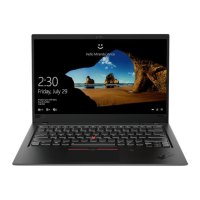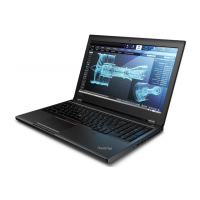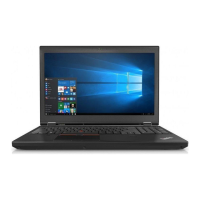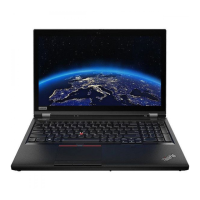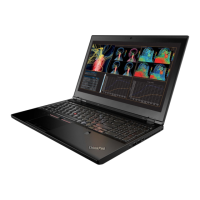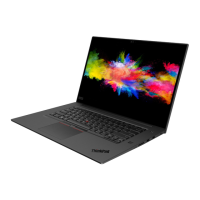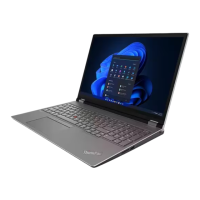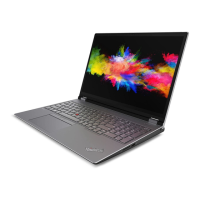Do you have a question about the Lenovo ThinkPad P43s and is the answer not in the manual?
General safety rules to ensure user safety during maintenance and operation.
Rules for working safely with electrical equipment to prevent shock and damage.
Checklist to identify potentially unsafe conditions before servicing the computer.
Procedures to protect sensitive electronic components from ESD damage.
Importance of proper electrical grounding for operator safety and system function.
List of languages for safety notices provided in the manual.
Guidelines for efficient and correct replacement of Field Replaceable Units (FRUs).
Procedure for replacing storage drives, including data backup advice.
Precautions for handling sensitive system boards to prevent damage.
Guidance on diagnosing failures using error codes displayed on screen.
Information on FRU replacement strategies for different model types.
Introduction to different model types and their identification methods.
Instructions on how to identify Field Replaceable Units (FRUs) for products.
Initial steps and information required when returning a FRU or parts.
Procedures for identifying and correcting problems with the ThinkPad notebook computer.
Steps and tools, like Lenovo Vantage, for diagnosing computer issues.
Using quick test programs to troubleshoot and resolve computer problems.
Using the preinstalled UEFI diagnostic program for system information and hardware tests.
Creating and using bootable diagnostic programs from Lenovo Support.
Procedures to verify the functionality of the battery or ac power adapter.
Using Windows recovery options to reset or restore the computer.
Steps to reset the computer, with options to keep or remove files.
Accessing advanced startup options for firmware and OS settings.
Procedures for recovering the OS when Windows 10 fails to boot.
How to create and use a recovery USB drive for system recovery.
Information on power-on, hard disk, supervisor, and system management passwords.
How the power-on password protects the system from unauthorized startup.
Details on user and master hard disk passwords for data security.
Supervisor password security features and system configuration protection.
System management password for UEFI BIOS security and control features.
Step-by-step instructions to remove the power-on password.
Procedures for removing forgotten user and master hard disk passwords.
Steps to remove system management password via Setup program or battery removal.
Explanation of computer power management modes: sleep and hibernation.
Describes events when the computer enters sleep mode and how to resume.
Describes events when the computer enters hibernation mode and how it stores data.
Index linking symptoms and errors to FRUs or corrective actions.
Identifies the location of computer controls, connectors, and indicators.
Introduces service parts like Major FRUs, LCD FRUs, and miscellaneous parts.
Explains Customer Replaceable Units (CRUs) and customer responsibilities.
Lists the necessary tools for servicing a ThinkPad notebook computer.
Information on special nylon-coated screws for reliability and tightening procedures.
Instructions on restoring system unit serial numbers and retaining UUIDs.
Steps to restore the system unit's serial number after system board replacement.
Guidance on creating a new Universally Unique Identifier (UUID) for a system board.
Explains Customer Replaceable Units (CRUs) and customer responsibilities.
General rules to follow when removing or replacing any FRU.
Pre-servicing checks, including disabling the battery and removing SIM cards.
Steps to disable the internal battery before performing maintenance.
Procedure for removing the nano-SIM card and tray before servicing.
Refers to User Guide for Class B digital device emission information.
Lists trademarks related to Lenovo, Microsoft, Intel, and HDMI.
General safety rules to ensure user safety during maintenance and operation.
Rules for working safely with electrical equipment to prevent shock and damage.
Checklist to identify potentially unsafe conditions before servicing the computer.
Procedures to protect sensitive electronic components from ESD damage.
Importance of proper electrical grounding for operator safety and system function.
List of languages for safety notices provided in the manual.
Guidelines for efficient and correct replacement of Field Replaceable Units (FRUs).
Procedure for replacing storage drives, including data backup advice.
Precautions for handling sensitive system boards to prevent damage.
Guidance on diagnosing failures using error codes displayed on screen.
Information on FRU replacement strategies for different model types.
Introduction to different model types and their identification methods.
Instructions on how to identify Field Replaceable Units (FRUs) for products.
Initial steps and information required when returning a FRU or parts.
Procedures for identifying and correcting problems with the ThinkPad notebook computer.
Steps and tools, like Lenovo Vantage, for diagnosing computer issues.
Using quick test programs to troubleshoot and resolve computer problems.
Using the preinstalled UEFI diagnostic program for system information and hardware tests.
Creating and using bootable diagnostic programs from Lenovo Support.
Procedures to verify the functionality of the battery or ac power adapter.
Using Windows recovery options to reset or restore the computer.
Steps to reset the computer, with options to keep or remove files.
Accessing advanced startup options for firmware and OS settings.
Procedures for recovering the OS when Windows 10 fails to boot.
How to create and use a recovery USB drive for system recovery.
Information on power-on, hard disk, supervisor, and system management passwords.
How the power-on password protects the system from unauthorized startup.
Details on user and master hard disk passwords for data security.
Supervisor password security features and system configuration protection.
System management password for UEFI BIOS security and control features.
Step-by-step instructions to remove the power-on password.
Procedures for removing forgotten user and master hard disk passwords.
Steps to remove system management password via Setup program or battery removal.
Explanation of computer power management modes: sleep and hibernation.
Describes events when the computer enters sleep mode and how to resume.
Describes events when the computer enters hibernation mode and how it stores data.
Index linking symptoms and errors to FRUs or corrective actions.
Identifies the location of computer controls, connectors, and indicators.
Introduces service parts like Major FRUs, LCD FRUs, and miscellaneous parts.
Explains Customer Replaceable Units (CRUs) and customer responsibilities.
Lists the necessary tools for servicing a ThinkPad notebook computer.
Information on special nylon-coated screws for reliability and tightening procedures.
Instructions on restoring system unit serial numbers and retaining UUIDs.
Steps to restore the system unit's serial number after system board replacement.
Guidance on creating a new Universally Unique Identifier (UUID) for a system board.
Explains Customer Replaceable Units (CRUs) and customer responsibilities.
General rules to follow when removing or replacing any FRU.
Pre-servicing checks, including disabling the battery and removing SIM cards.
Steps to disable the internal battery before performing maintenance.
Procedure for removing the nano-SIM card and tray before servicing.
Refers to User Guide for Class B digital device emission information.
Lists trademarks related to Lenovo, Microsoft, Intel, and HDMI.
| Form factor | Clamshell |
|---|---|
| Product type | Mobile workstation |
| Product color | Black |
| LED backlight | Yes |
| Display diagonal | 14 \ |
| Display brightness | 400 cd/m² |
| Native aspect ratio | 16:9 |
| Contrast ratio (typical) | 1000:1 |
| Bus type | OPI |
| Tjunction | 100 °C |
| Processor cache | 8 MB |
| Processor cores | 4 |
| System bus rate | 4 GT/s |
| Processor family | Intel® Core™ i7 |
| Processor socket | BGA 1528 |
| Processor threads | 8 |
| Processor codename | Whiskey Lake |
| Configurable TDP-up | 25 W |
| Processor frequency | 1.8 GHz |
| Processor cache type | Smart Cache |
| Configurable TDP-down | 10 W |
| Processor lithography | 14 nm |
| Processor manufacturer | Intel |
| PCI Express slots version | 3.0 |
| Processor boost frequency | 4.6 GHz |
| Processor operating modes | 64-bit |
| PCI Express configurations | 1x4, 2x2 |
| Thermal Design Power (TDP) | 15 W |
| Configurable TDP-up frequency | 2 GHz |
| Configurable TDP-down frequency | 0.8 GHz |
| Maximum number of PCI Express lanes | 16 |
| Motherboard chipset | Intel SoC |
| Memory slots | 1x SO-DIMM |
| Internal memory | 32 GB |
| Memory clock speed | 2400 MHz |
| Memory form factor | On-board + SO-DIMM |
| Internal memory type | DDR4-SDRAM |
| Maximum internal memory | 48 GB |
| Memory layout (slots x size) | 1 x 16 GB |
| SSD capacity | The Solid State Drive's storage capacity in Gigabytes. |
| SSD interface | NVMe, PCI Express |
| Storage media | SSD |
| SSD form factor | M.2 |
| Total storage capacity | 512 GB |
| Compatible memory cards | MicroSD (TransFlash) |
| Number of SSDs installed | 1 |
| Maximum resolution | 3840 x 2160 pixels |
| On-board graphics card ID | 0x3EA0 |
| Discrete graphics card model | NVIDIA Quadro P520 |
| Discrete graphics card memory | 2 GB |
| Discrete graphics memory type | GDDR5 |
| On-board graphics card family | Intel® UHD Graphics |
| On-board graphics card OpenGL version | 4.5 |
| On-board graphics card base frequency | 300 MHz |
| On-board graphics card DirectX version | 12.0 |
| On-board graphics card dynamic frequency (max) | 1150 MHz |
| Audio chip | Realtek ALC3287 |
| Audio system | Dolby Audio Premium |
| Speaker power | 2 W |
| Number of built-in speakers | 2 |
| Privacy type | Privacy shutter |
| Front camera HD type | HD |
| Front camera signal format | 720p |
| Antenna type | 2x2 |
| Wi-Fi standards | 802.11a, Wi-Fi 5 (802.11ac), 802.11b, 802.11g, Wi-Fi 4 (802.11n) |
| Bluetooth version | 5.0 |
| Top Wi-Fi standard | Wi-Fi 5 (802.11ac) |
| WLAN controller model | Intel Dual Band Wireless-AC 9560 |
| Ethernet LAN data rates | 10, 100, 1000 Mbit/s |
| HDMI version | 1.4b |
| Charging port type | USB Type-C |
| USB 2.0 ports quantity | 0 |
| Pointing device | ThinkPad UltraNav |
| Keyboard language | US English |
| Operating system language | English |
| Processor ARK ID | 149091 |
| Intel TSX-NI version | 0.00 |
| Processor package size | 46x24 mm |
| Supported instruction sets | AVX 2.0, SSE4.1, SSE4.2 |
| Intel Identity Protection Technology version | 1.00 |
| Battery capacity | 50 Wh |
| Battery life (max) | 14.7 h |
| AC adapter power | 65 W |
| AC adapter frequency | 50 - 60 Hz |
| AC adapter input voltage | 100 - 240 V |
| Password protection type | HDD, Power on, Supervisor |
| Sustainability certificates | RoHS, EPEAT Silver, ENERGY STAR |
| Depth | 227 mm |
|---|---|
| Width | 329 mm |
| Height | 17.9 mm |
| Weight | 1550 g |

